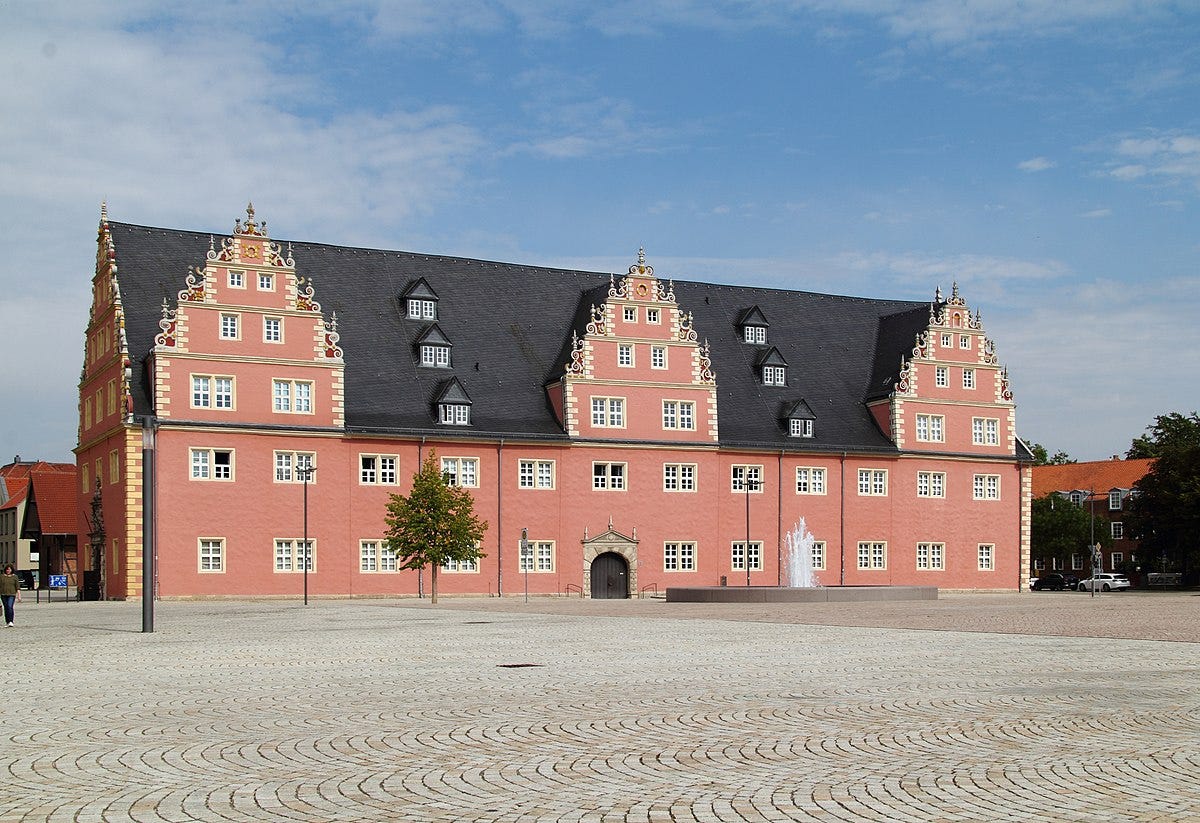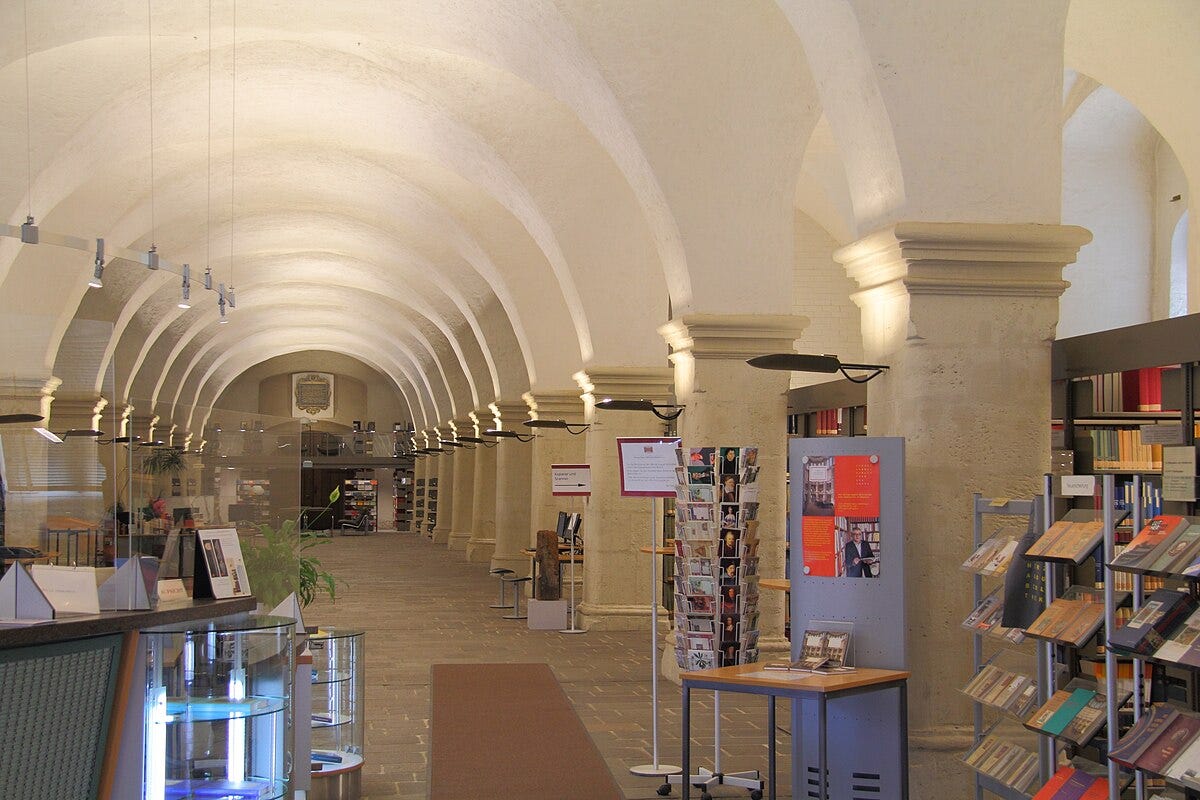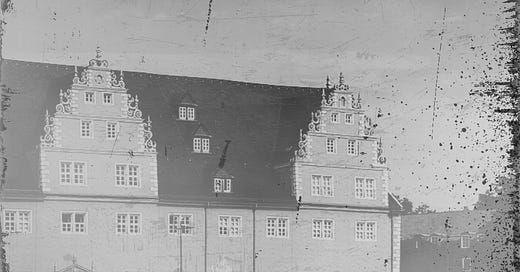We called it the Zeughaus, the German word for armory (literally “equipment house”), the building where I spent nearly two years reading sources for my doctoral dissertation.
By then, it had long been converted into a research library for early modern cultural historians, but originally it had been a ducal armory, and we still referred to it as such. (And we shall beat our swords into… 16th-century sermons?)

Outside, the Zeughaus was a boxy fortress of a building with clear, if somewhat vague, historical elegance. Its architectural features were pretty understated, with little ornamentation besides a few window details and an eye-catching, pink exterior—a shade somewhere between burgundy and terracotta that reminded me of roses and kitten noses and baked-clay romanesque statues.
Located across the street from a ducal palace and within walking distance of countless other historical gems, the Zeughaus didn’t exactly draw crowds. It stood there, always striking me as a little corpulent, as though the windows it wore had shrunk in the dryer at some point.
But we can forgive its homeliness—it’s an armory, after all, not Notre Dame. It’s not trying to seduce the world with delicate curves or flying buttresses.
And despite everything else, the Zeughaus had its own kind of beauty. The kind that spoke of safety and impenetrability and proximity to the earth. The kind that, despite its rugged age and stature, still blushed in the light of a setting sun.

“The body is our armory; the [soul] is the soldier. Treat them each judiciously, so that you can be ready for anything.”
It’s not often I conjure up the months and years I worked in the Zeughaus—for all their historical charm, recounting those memories is like visiting a cemetery of academic dreams and ideals I once thought I wanted, but later abandoned. Despite what there was to love about them, and despite the people who supported me along the way. It was the right choice, but still a painful one.
It is more than a decade later, on a day when life and bodies and other things do not make much sense to me, when I find these words—or rather, they find me:
“The body is our armory; the soul is the soldier. Treat them each judiciously, so that you can be ready for anything.”1
They are a gift from Holy Synkletika, one of the Desert Mothers (yes, they exist), and they catch me off guard. It is not often, after all, that one finds what could be called “body-positive” (or even body-neutral) sentiments in the writings of the ascetics, bless their hearts.
As I write this now, the sun bakes the bricks of my house—it is only 10AM, and already a heat advisory is in effect—but it is cool and shady within my home office, a different sort of fortress.
I am reading, and I am writing. I am thinking about what it means to have a body. And I am remembering what it is like to be in an armory.

Walking into the Zeughaus, it took time for my eyes to adjust from the sunlight.
The Roman-vaulted corridors cast shadows of dark, clammy impenetrability. Its outer walls, hewn half a millennium ago from giant slabs of rock, were several feet thick—little light made it past the massive sills of those tiny windows (tiny by design, one now realizes, since anything bigger would have crumbled under the weight of fortress walls).
“Our body is an armory, the soul is the soldier.”
Our body is the thing that protects, shields, and houses what is needed to fight a battle. It helps to keep our soul safe, and equips our nous with the tools it may need to face an attack.

When Holy Synkletika compares our body to an armory, she is talking about about the need for moderation. Balance.
She is trying to help people understand the risk of being too hard on the body for a supposedly spiritual purpose.
Certain desert pilgrims she met took on a “kind of intensified asceticism,” increasing their spiritual efforts until they are “fasting for four or five days at a time, followed by eating too much.”
For Synklektika, the proper antidote to this ‘spiritual yo-yo dieting,’ is moderation and proportion and, alas, sameness. She suggests that for some, it’s better to follow the same rule of prayer and/or fasting, even if it becomes less challenging over time, rather than trying to improve on it only to end up going to extremes.
“It is always the unbalanced actions which are the most debilitating,” she says. “Do not bring out every weapon you have all at once lest you find yourself in the midst of battle with no weapons left. The body is our armory; the soul is the soldier. Treat them each judiciously, so that you can be ready for anything.”
To put it another way: faith is a lifestyle, not a diet.
As my time at the Zeughaus trickled on, I noticed more of its wounds.
Some of the stone walls that had once appeared to gleam a pristine gray, I now realized were scratched by rough handling and stray bullet holes from long-forgotten battles (or, more likely, clumsy armorers).
And one day as I showed up for work, the cobblestone street to the Zeughaus was blocked by firetrucks and construction vehicles. Evidently, the contractors fixing the roof had forgotten to cover their work before leaving the previous day—a modest overnight rainstorm had resulted in water damage and several ruined (very old and irreplaceable) books.
Even armories are fragile. Even stonework can be scarred.
“Treat them judiciously…”

One day last fall, caught in the rain while browsing the vendor stalls of a street fair, I snuck under the stone archway of one of the old buildings of the city I now live in, in Southern Ontario. Looking around while I shook the water off my jacket, it dawned on me I was standing inside the imposing local military armory (which currently houses the Argyll and Sutherland Highlanders of Canada reserves, because Canada).
Usually closed to visitors, the armory had opened their gates for the street fair, and the central courtyard was filled with camouflage tents, military personnel dressed in iconic Scottish fatigues, and other civilians like myself, gawking in the now steady rain.
All at once, an army’s worth of bagpipes reverberated off the brick walls enclosing the courtyard. A kilted troupe of bagpipers marched out of another Escherian stone archway—one I hadn’t noticed before—eventually filling the center of the courtyard.
For five or ten transfixed minutes, the air was filled with their piercing yet oddly wistful billows.
What magical place had I stumbled into? I smiled, tears and raindrops pooling in the corners of my eyes.
Even on the brighter days, an armory is a vaguely pessimistic place. A place of necessary darkness, of fearful protection, a place that only exists because of war.
But sometimes, when it is filled with music, or books, or the gentle rains of a benevolent heaven, the beauty makes you weep.

Now that I’ve been thinking about this, armories and weapon storage are everywhere lately.
Last week, I listened to a recent episode of the Court Junkie podcast about the case of Hannah Guitierrez-Reed, staff armorer on the movie set where actor Alec Baldwin accidentally shot and killed cinematographer Halyna Hutchins in 2021.
Setting the tragedy of this case aside, the episode was a fascinating glimpse into the steps taken—or, in this case, not taken—to store weapons and ammunition safely on movie sets.
How many armorers do you know? And yet, apparently, they are one of the most important people on a movie set where guns—even artificial ones—are used. Because anyone can switch out a convincing fake gun with a real one. And anyone can switch out blanks with real bullets. And know one would spot the difference unless they know guns like the back of their hand.
In this case, there was no single person or action responsible for Hutchins’ death, but rather a cascading series of unfortunate mistakes and cut-corners. An overworked staff. A gun enthusiast who accidently let real bullets circulate on the movie set. Rushed safety checks.
It is no small thing to be the bearer of weapons, whether they are physical or spiritual, good or ill.
“Do not bring out every weapon you have all at once lest you find yourself in the midst of battle with no weapons left.“

What’s left when what all that’s nonessential falls away?
Our body is an armory… Our body is the thing that protects, shields, and houses what is needed to wage a battle and live a life. It helps to keep our mind and soul safe, it equips our nous with the tools it needs, especially when it’s under attack.
Treat each of them judiciously… Don’t be afraid to let in some light. Don’t be clumsy or impatient with weapons you’re not even ready for in the first place. Don’t be inattentive and expose your armory to elements that will cause harm.
And let beauty win. Not the beauty of supermodels, but of stability and eternity and longsuffering.
In this life, our armory may sometimes seem like a dark, unyielding place to tend our souls. But I long for the day when these walls will be broken with music, these windows shattered with sunlight, and these weapons restored to wisdom.
Source info: The Sayings of the Desert Fathers, Orthodox Empirical Theologians Series Vol. 46 (Florence, AZ: Sagom Press, 2019), 127-28.






Thank you for this- there is a lot to think about here.